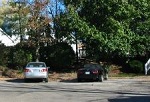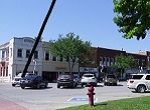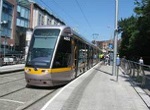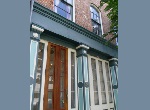Strip Mall Redevelopment To Become an Even Bigger Issue
Last Updated: March 8, 2024
Strip mall redevelopment should be on the agenda for almost every suburban government. This topic applies to small towns, small cities, and many central cities as well. Strip retail centers oriented primarily parallel to major streets or highways, with parking in the front, are the ultimate in automobile-oriented retailing.
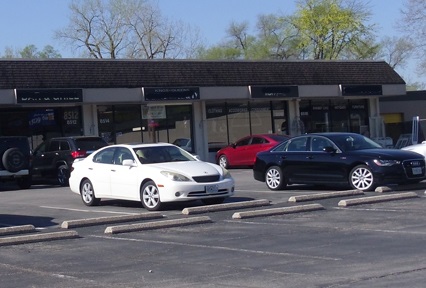
We wrote our headline before the coronavirus pandemic hit, but we think that now you have to "double down" on addressing strip malls that are not thriving. Some less viable businesses probably have gone away, and others are hobbling along trying to regain their previous sales level. If they aren't back to pre-Covid levels, or nearly so, chances are good that the market has changed.
Strip shopping centers may consist of a series of small convenience retail storefronts, such as the one shown above. Typically uses such as dry cleaners, beauty salons or barber shops, pizza joints, sandwich shops, or maybe a tiny locally owned pharmacy would occupy 1500-2000 square feet each.
Larger developments may include one or more anchor tenants, the most common being a grocery store, usually one that is small by today's standards. A chain drug store or even a smaller version of what is typically a big box, such as a Target or Walmart, might be included in the largest of this type.
Satellite stores might be in the same building or in other buildings sharing the same parking. Shapes of the largest building might fall into a straight line or an L shape or U shape. But we think all of these types bring many potential pitfalls, especially if they are not located at an important intersection.
7 Reasons for Strip Center Decline
- Many such centers now have succeeded too well. As traffic clogs major arterial streets, it becomes less and less convenient to enter and exit from these strip centers. The convenience factor melts away.
- Rents in strip centers in many parts of the U.S. are decreasing not only because of traffic congestion, but also because of changing shopping habits. The major shift toward online shopping is now obvious to all but the most accomplished Luddites.
- The recession of 2008-2012 also weeded out many of the retailers who had occupied strip center spaces. This included both failed national or regional chain stores and local mom and pop stores that once were successful. Add in the pandemic problems, and we can see why demand for space is fairly low.
- Overbuilding of such space also is another factor in the over-supply that is clear to both citizen and professional observers in most metro areas. According to an Urban Land Institute article, there may be five to six times as much of this type of retail space as is needed. When developers find a money-making formula that works, they tend to overdo it. Who can blame them?
- Larger retailers and fast food chains now have some experience with alternative layouts and looks that are more compatible with a traditional downtown or district setting. These operators often occupy outlots on the edges of larger strip centers. If they are no longer intimidated by developing where millennials increasingly prefer to live in or near the urban core, these anchors of many strip malls will no longer be as motivated to remain in suburban type locations.
- Developers may get too greedy and make mistakes. This could be a whole page in itself, but the list includes lack of focus, a location where many storefronts are not visible from the road (or not visible from the most advantageous road), building too much space to fill up with the small mom-and-pop type uses, foolish choices such as building on a second story where space is not really at a premium, a center that is too deep or too shallow, too much satellite space as compared to anchor store square footage, or parking that is not directly adjacent to storefronts.
- We believe that tastes have been changing for a while, with people actually realizing that a large expanse of parking lot is an ugly thing. The four rows of parking in front of the typical small strip shopping center may have worked in favor of the development initially, but slowly potential customers are waking up to the bland sameness.
Let us explore a little further the phenomenon of younger people wanting to live in exciting and unpredictable urban environments, even preferring in some cases to forego automobile ownership in favor of more walkable environments.
In many cities, this hunger for urban life fades about the time that children arrive, but yet the demographic pattern of delayed marriage and child-rearing means that for a number of years, young people who are establishing households want to walk through an urban type environment.
We are now observing many young parents who want to continue their pre-baby habits of walking to shops, restaurants, and bars. But when those destinations lie within a strip mall, most young parents will think that is not a safe or desirable environment for walking with a stroller.
All of this adds up to decreased demand for retail activity along highways and major streets, and in the suburbs or in suburban-type built environments, regardless of whether inside the boundaries of a central city or not.
What Strip Mall Redevelopment Solutions Are Possible?
Since we expect the pace of strip mall redevelopment experiments to pick up a bit in the next few years, especially if interest rates decline while the economy remains steady, there is no single conventional recommendation or solution just yet.
That's a good thing, as it will allow us to experience a variety of proposed and built redevelopment approaches. Once a solution becomes formulaic, it too may become failure-prone.
Thus far what tends to happen is that the strip mall will be sold and the new owner will attempt a major facelift. Sometimes this works for a while, especially if star tenants can be attracted. However, it is unlikely to be a solution that lasts for very many years. Notice that most of the trends cited at the beginning of this article do not refer to the appearance of the shopping center.
Sometimes new owners will be a bit smarter and attempt to develop a new outlot, or a liner building, as a new shallow buildings up next to the street in front of the suburban-style parking is called. This new space also may lead to success for a few years, but it is unlikely to be a long-lasting win for the community, due to the oversupply we have cited already, which in turn leads to an excessive vacancy factor. Even improved urban design cannot compensate for lack of market demand.
In sound suburban markets, a new owner may demolish the existing structure or structures and build a more contemporary-looking center, perhaps with some or many storefronts near the arterial street. In some areas, land may represent two-thirds of more of the value of the center, so this approach can make sense. (The fact that tax laws allow an overly generous depreciation of retail facilities also lends a helping hand toward this rapid obsolescence cycle.)
The demolition and reconstruction approach often represents an improvement for the community, providing that is sufficient demand for retail and service businesses common in strip centers. But it will be an improvement only if it incorporates the basic element of walkability. Many strip mall redevelopment projects will sport a wide sidewalk next to the street or highway, but are not really pedestrian friendly due to the speed of traffic, lack of an appropriate landscape buffer from the road, and lack of pedestrian connections at the ends and rear of the strip mall.
A more radical approach, but the one likely to bring more long-range results, starts with a sober assessment of the demand for retail and services of the type often located in strip centers. An analysis of the competition frequently shows that the supply already exceeds demand.
Often planning commissions and city councils are told that market analysis is none of their business. We don't believe that. If you are in a state where case law upholds the obnoxious idea that demand is none of the public sector's business, of course be careful what you do. But formally or informally, public planning decisions should take place in an atmosphere of realism about markets. Adopting such a stance would include the probably unpopular process of down-zoning where appropriate.
What to Do If Demand Is Insufficient
In the somewhat probable event that you find that your strip mall
redevelopment is unlikely to
be successful if it encompasses the same or very similar uses, then you
need to become open to some fairly drastic changes of land use.
Effective strategies for moving away from neighborhood commercial and
service businesses might include:
- Broadening the range of permitted uses to include institutional uses such as churches, social service agencies, and governmental offices. Admittedly, sometimes such uses already are permitted under the zoning ordinance, but property owners are reluctant to take on these uses as tenants. They perceive institutional users to be less willing to pay nice rents, and they may be right on that point. (You could argue that this may be true, but institutional tenants are probably more reliable about paying the rent!)
- At least near major intersections that can handle the traffic, land uses appropriate for deeper parcels, including larger stores, churches, and office buildings, could be added or substituted for existing buildings that are configured with smaller bays. This may entail having to create and rezone deeper lots to encompass these larger buildings. Yes, this can be a long and tedious process, but how many years are you willing to wait for your half-vacant strip mall to fill up again?
- Redevelopment as housing, especially multi-family housing. Granted, many buyers and renters do not want to be located along a major street, but various townhome, condominium, and multi-family housing styles can manage to fit in quite well along an arterial street, especially where vehicular access is controlled or can be controlled easily enough. Of course the infill housing probably will be more successful if housing units maximize a view other than the one of the busy street. Unless you are looking at strip mall redevelopment of a larger center, these developments also will require reconfiguration of lots into deeper parcels and possibly rezoning some single-family parcels to multi-family or planned development districts.
- If the public sector really wants to resolve a particular strip shopping center failure or under-performance, some scholars and dreamers propose converting them to a much-needed park, community center, youth center, or urban farm. The problem that we see with these kinds of proposals is the need for the city to acquire the land for that to happen. No doubt that would be an expensive acquisition, since appraisers would tend to stick with the commercial property designation.
Ultimately many municipalities need to consider the housing solution to strip mall redevelopment. Demand for land for churches and offices is finite, just as the need for retail space is limited, so some jurisdictions are as seriously overbuilt for office as for retail land uses. In some places the demand for housing is maxed out as well, but healthy and growing economies continually need a few more housing units each year.
The possible variations for your situation are endless, of course, but in closing, we would emphasize these points.
- Both local governments and property owners must be utterly and completely realistic about market demand and existing supply, including supply that is approved but not yet built in your own or neighboring jurisdictions,
- Proactively manage zoning and associated approvals to bring about a desirable result, which may include rezoning parcels behind the strip center to allow for increased commercial lot depth in the future, down-zoning to reduce future overbuilding, and possibly a program of strategic down-zoning and up-zoning. Though difficult politically, this could create a good long-term solution. Down-zoning would occur on lengthy expanses between major intersections, with up-zoning to permit more intense development near intersections.
- Emphasize walkability as a community, benefiting not only strip mall redevelopment but also many other quality of life factors. Shining a spotlight on walkability will help you focus in on strip mall appearance and functioning too.
Read About Topics Related to Strip Mall Solutions
- Making and Keeping a Good Community >
- Community Challenges, Common Topics & Concepts >
- Redevelopment > Strip Mall Redevelopment
Join GOOD COMMUNITY PLUS, which provides you monthly with short features or tips about timely topics for neighborhoods, towns and cities, community organizations, and rural or small town environments. Unsubscribe any time. Give it a try.
